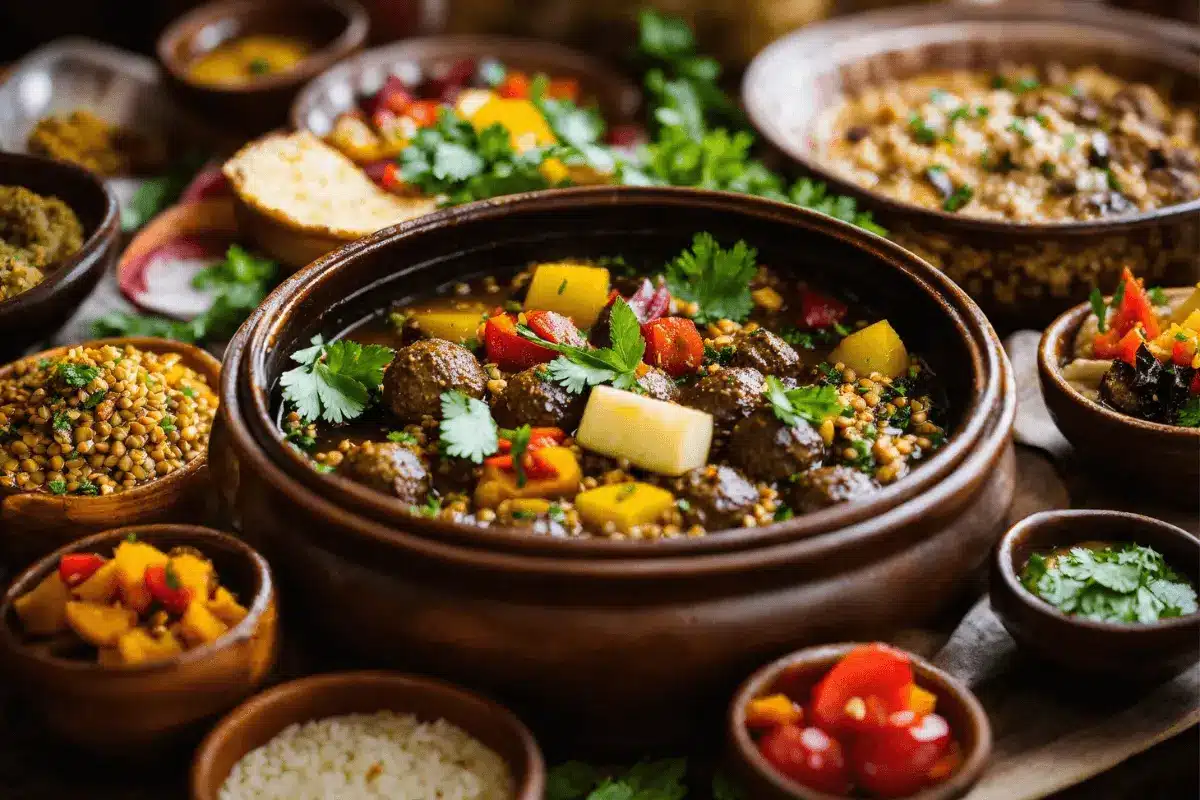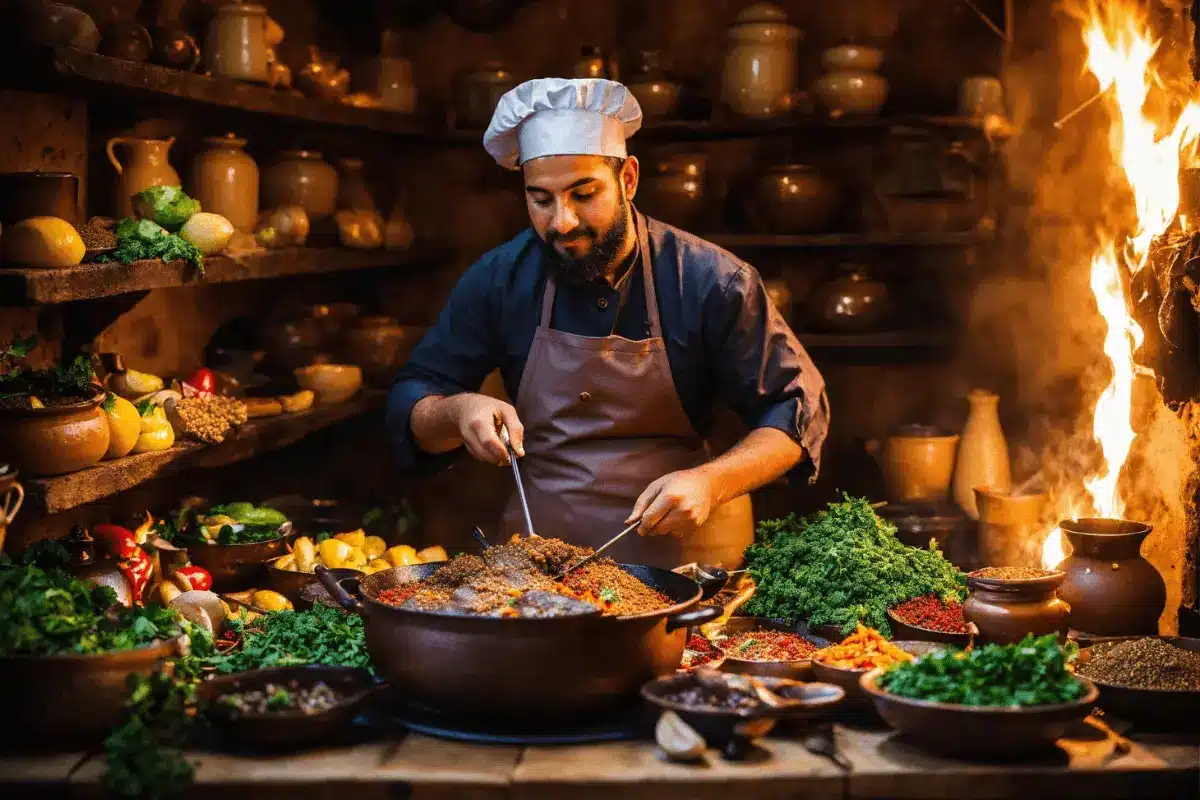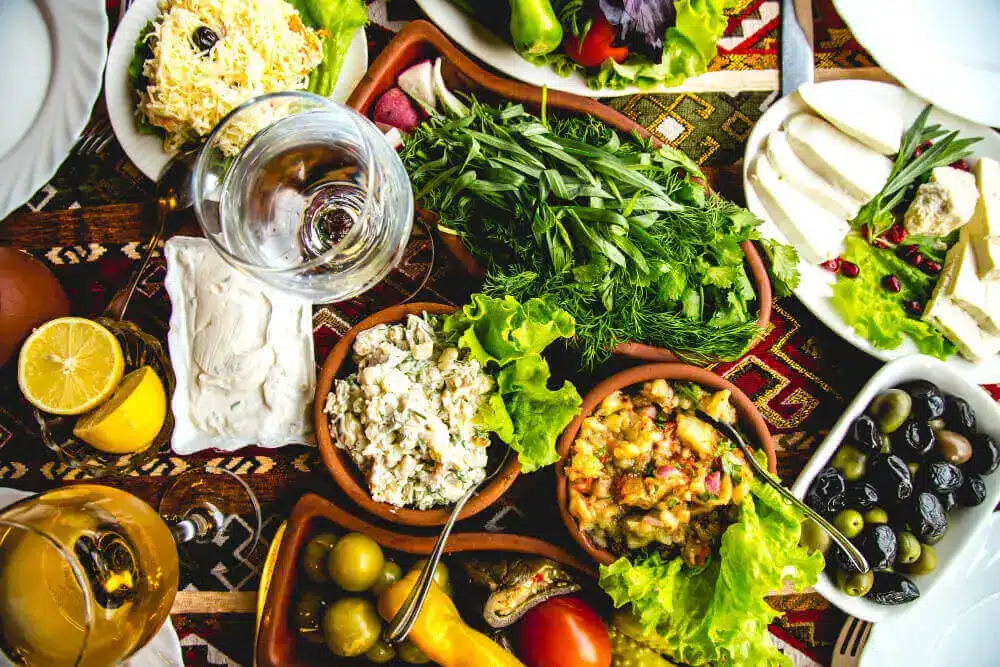Introduction to Middle Eastern Vegetarian Cuisine
The Richness of Middle Eastern Flavors
Middle Eastern Vegetarian Recipes, a tapestry of tantalizing tastes and aromas, offers a cornucopia of vegetarian delights. Each dish is a symphony of flavors, blending spices like sumac and za’atar with fresh herbs and wholesome ingredients. This cuisine is not just about food; it’s a celebration of culture and tradition, bringing people together around the dining table.
Health Benefits of Middle Eastern Vegetarian Diet

Adopting a Middle Eastern vegetarian diet isn’t just a treat for your taste buds; it’s a boon for your health too!. For more perspectives, explore community insights on vegetarian Middle Eastern dishes shared by various individuals. Rich in fiber, vitamins, and minerals, these dishes are heart-healthy and great for digestion. Ingredients such as chickpeas, lentils, and eggplant are not only nutritious but also incredibly versatile. Consequently, this makes Middle Eastern vegetarian recipes an excellent and appealing choice for those who are looking to spice up their diet while simultaneously keeping it healthy.
In the next section, we’ll explore some of the most popular Middle Eastern vegetarian dishes. For an additional guide, check out this guide to the best vegetarian Middle Eastern dishes to enhance your culinary adventure that are not only easy to make but also brimming with flavor and tradition. Stay tuned for a culinary adventure that promises to be as enriching as it is delicious!
Exploring Popular Middle Eastern Vegetarian Dishes

Batata Harra – Lebanese Spiced Potatoes
A staple in Lebanese cuisine, Batata Harra is a fiery delight. These crispy potatoes, seasoned with garlic, cilantro, and the perfect kick of chili, are a testament to the simple yet robust flavors of the Middle East. They’re not just a side dish; they’re a conversation starter!
Vegetarian Lebanese Recipes Overview
Lebanese vegetarian dishes are a mosaic of flavors. From the tangy and refreshing Tabbouleh to the rich and creamy Hummus, these recipes are a testament to Lebanon’s rich culinary heritage. Each dish is a celebration of fresh ingredients and aromatic spices, offering a healthy and flavorful dining experience.
Muhammara Chickpea Skillet
This dish is a vibrant fusion of textures and tastes. Muhammara, with its unique blend of roasted red peppers and walnuts, combined with chickpeas, creates a hearty and satisfying meal. It’s a perfect example of how Middle Eastern cuisine can turn simple ingredients into a feast for the senses.
Cooking Techniques and Ingredients

Key Spices and Herbs in Middle Eastern Cuisine
Middle Eastern cooking is unimaginable without its array of spices and herbs. Sumac, with its tangy lemony flavor, and Za’atar, a blend of herbs and sesame seeds, are just the tip of the iceberg. These spices don’t just add flavor; they weave stories and traditions into every dish.
Cooking Methods Unique to Middle Eastern Cuisine
The cooking methods in Middle Eastern cuisine are as diverse as its flavors. Slow-cooking stews bring out deep, complex flavors, while grilling and roasting enhance the natural tastes of vegetables and herbs. These techniques are not just about cooking food; they’re about respecting and celebrating the ingredients.
Step-by-Step Middle Eastern Vegetarian Recipes
Recipe 1: Detailed Guide – Falafel
Ingredients:
- 2 cups dried chickpeas, soaked overnight
- 1 small onion, roughly chopped
- 2-3 garlic cloves, minced
- 1/4 cup fresh parsley, chopped
- 1/4 cup fresh cilantro, chopped
- 1 tsp ground cumin
- 1 tsp ground coriander
- 1/2 tsp cayenne pepper
- Salt and black pepper to taste
- 1 tsp baking powder
- 2-3 tbsp flour
- Oil for frying
Instructions:
- Drain and rinse the soaked chickpeas. In a food processor, combine chickpeas, onion, garlic, parsley, cilantro, cumin, coriander, cayenne, salt, and pepper. Process until blended but not pureed.
- Transfer to a bowl, and stir in baking powder and enough flour to form a dough that holds together. Let it rest for 15-30 minutes.
- Heat oil in a deep fryer or a deep pan to 350°F (175°C). Form the chickpea mixture into balls or patties.
- Fry in batches, without crowding, until golden brown, about 5 minutes. Drain on paper towels.
- Serve hot with tahini sauce, fresh vegetables, or in a pita bread.
Recipe 2: Detailed Guide – Fattoush
Ingredients:
- 2 cups of lettuce, chopped
- 1 cup cherry tomatoes, halved
- 1 cucumber, diced
- 1/2 red onion, thinly sliced
- 1/2 cup fresh mint, chopped
- 1/2 cup fresh parsley, chopped
- 2 pita breads, toasted and broken into pieces
- 1/4 cup olive oil
- 2 tbsp lemon juice
- 1 tsp sumac
- Salt and pepper to taste
Instructions:
- In a large salad bowl, combine lettuce, tomatoes, cucumber, red onion, mint, and parsley.
- In a small bowl, whisk together olive oil, lemon juice, sumac, salt, and pepper to make the dressing.
- Add the toasted pita pieces to the salad and pour the dressing over the salad. Toss everything together until well combined.
- Serve immediately to enjoy the crunch of the pita.
Recipe 3: Detailed Guide – Stuffed Grape Leaves
Ingredients:
- 1 jar grape leaves, rinsed and drained
- 1 cup rice, rinsed and drained
- 1/4 cup olive oil
- 1 onion, finely chopped
- 1/4 cup fresh dill, chopped
- 1/4 cup fresh parsley, chopped
- 1/2 tsp ground cinnamon
- 1/2 tsp ground allspice
- Salt and pepper to taste
- 2 cups vegetable broth
Instructions:
- In a bowl, mix rice, olive oil, onions, dill, parsley, cinnamon, allspice, salt, and pepper.
- Lay a grape leaf flat on a work surface. Place a small amount of the rice mixture near the stem end. Fold in the sides and roll the leaf tightly.
- Place the stuffed leaves seam side down in a pot. Repeat with remaining leaves and filling.
- Pour vegetable broth over the stuffed leaves. Cover and simmer over low heat for about 1 hour until leaves are tender and rice is cooked.
- Serve warm or at room temperature with a squeeze of lemon.
These recipes bring the essence of Middle Eastern vegetarian cuisine into your kitchen. Each dish, with its unique blend of flavors and textures, offers a delightful experience that is both nutritious and satisfying. Enjoy the process of creating these culinary delights and share the joy of Middle Eastern cooking with your loved ones.
Frequently Asked Questions About Middle Eastern Vegetarian Recipes
Q1: Can I use canned chickpeas for making Falafel?
A1: While canned chickpeas are convenient, for the best texture and flavor in Falafel, it’s recommended to use dried chickpeas that have been soaked overnight. Canned chickpeas tend to be too soft and may result in a mushy texture.
Q2: Are Middle Eastern vegetarian dishes healthy?
A2: Absolutely! Middle Eastern vegetarian cuisine is known for its use of fresh vegetables, legumes, grains, and healthy fats like olive oil. These ingredients contribute to a balanced diet rich in nutrients, fiber, and healthy fats.
Q3: What are some common spices used in Middle Eastern vegetarian cooking?
A3: Middle Eastern cuisine is famous for its aromatic spices. Commonly used spices include cumin, coriander, sumac, za’atar, cinnamon, and allspice. These spices not only add flavor but also offer various health benefits.
Q4: How can I make my Middle Eastern dishes more flavorful?
A4: To enhance the flavors in your Middle Eastern dishes, use fresh herbs like parsley, mint, and cilantro. Also, don’t shy away from using spices and seasonings like lemon juice, garlic, and onions. Toasting spices before using them can also intensify their flavors.
Q5: Can Middle Eastern vegetarian dishes be made vegan?
A5: Many Middle Eastern vegetarian dishes are naturally vegan or can be easily adapted. For more ideas, you might want to explore these authentic vegetarian Middle Eastern recipes by Vidar Bergum. For example, you can substitute dairy ingredients with plant-based alternatives, like using tahini instead of yogurt in sauces and dips.
Q6: What are some tips for cooking perfect Mujadara?
A6: For a perfect Mujadara, cook the lentils and rice separately to avoid overcooking. Caramelize the onions slowly to bring out their sweetness, which is key to the dish’s flavor. Finally, be generous with seasonings to balance the earthiness of lentils and rice.
Q7: How long can I store these dishes?
A7: Most Middle Eastern vegetarian dishes store well in the refrigerator. Falafel and stuffed grape leaves can last up to 3-4 days, while salads like Fattoush are best eaten fresh. Always store in airtight containers to maintain freshness.
Conclusion
In this journey through Middle Eastern vegetarian cuisine, we’ve explored a world rich in flavors, traditions, and healthy eating. From the spicy Batata Harra to the comforting Mujadara, these dishes are more than just food; they’re a celebration of a vibrant and diverse culinary culture. Additionally, whether you’re a seasoned chef or a curious foodie, Middle Eastern vegetarian recipes offer a delightful and nutritious way to explore new flavors and traditions. Furthermore, these dishes provide an opportunity to immerse oneself in the rich tapestry of Middle Eastern cuisine.
Remember, each dish tells a story, and every bite is a step into a rich culinary heritage. So, embrace these flavors, experiment with these recipes, and enjoy the journey through the delicious world of Middle Eastern vegetarian cuisine.


6 thoughts on “Middle Eastern Vegetarian Recipes: 12 Delicious Culinary Dishes”